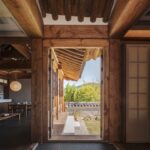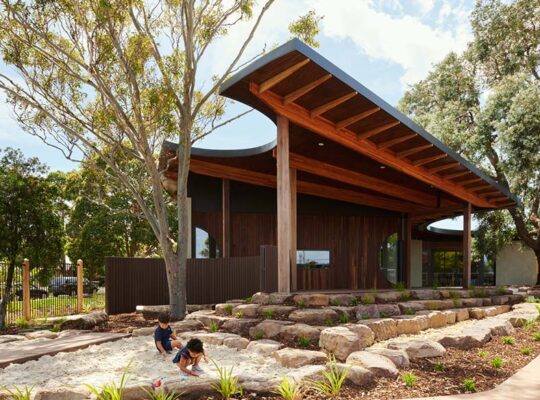Exploring the Essence of Hanok
Muuun Hotel, comprising two individual houses, draws its inspiration from the ethereal beauty of mist and clouds. Nestled near the picturesque ‘Samreung’ forest renowned for its misty landscapes, Muuun seeks to evoke a sense of surrealism akin to wandering through the mist-filled woods. By embracing traditional Korean architecture (hanok), the project aims to offer guests a transformative experience reminiscent of stepping into a different realm.

Liberating Hanok from Stereotypes
The early stages of the project involved an in-depth study of various hanok designs, prompting the designers to question the stereotypical perceptions surrounding this architectural style. Rather than adhering strictly to traditional or modern interpretations, Muuun Hotel sought to break free from conventional boundaries and explore a more fluid approach to hanok design.
Reimagining Hanok Architecture
With the client’s endorsement, the design team embarked on an unconventional path, envisioning two houses within a single site—a departure from the typical hanok layout. The focal point of the design is the courtyard, shaped like two intersecting “L”s, with each house featuring distinct views and entrances. Notable design elements include a curved entrance and a solid facade, offering a departure from traditional hanok architecture while ensuring privacy and visual appeal.
Harmonizing Tradition and Modernity
Each unit within the hotel follows a similar layout, with a living room near the entrance and a bedroom tucked away in the corner. While maintaining a sense of privacy, the houses also feature open spaces that connect seamlessly with the garden. Traditional Korean paper and hemp cloth doors add a touch of translucency, evoking the imagery of mist and clouds that inspired the hotel’s name.

Enhancing Comfort and Authenticity
To enhance the authenticity of the hanok experience, Muuun Hotel incorporates a blend of traditional and modern elements. While the living rooms feature conventional wooden floors, the bedrooms boast elevated bases adorned with clay plaster and linoleum flooring—a nod to traditional materials and techniques. The use of grey Korean paper for walls and ceilings further accentuates the hotel’s timeless charm.
Conclusion
Muuun Hotel offers guests a harmonious blend of tradition and innovation, inviting them to immerse themselves in the captivating beauty of hanok architecture. By reimagining traditional design principles and embracing modern comforts, Muuun creates a tranquil retreat where guests can reconnect with nature and embark on a journey of self-discovery.
























